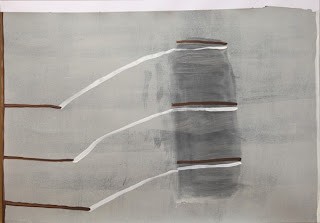Do again, 2011
oil on wood
24 x 18 x 2"
What are you working on in your studio right now?
I’ve just started working again since my first solo show, Blanks and Holes, which was held at DODGE gallery in New York this February-March. I have begun by responding to the work that was in that show and the remnant works that have popped up while cleaning the studio. In the show at DODGE, I was working with ideas about framing and the play between object and picture plane. The dominant format used was a traditionally proportioned rectangle in the “portrait” orientation.
My work attempts to go beyond making a picture, while staying within the parameters of painting. In response to my investigation of framing device I have made a large stack of panels that are slightly off the square. I am drawn to the awkwardness of this proportion while it throws a wrench into the mix of the whole conversation started with Blanks and Holes. It seems incongruous to paint or add frames to this shape, which is not in the language of portrait, landscape or digital screen.
Additionally I have made several supports to parody some of the older paintings. I’m interested to see what happens when I overtly address the innate fear of self-repetition by deliberately repeating myself. Maybe it’s a stupid exercise but that’s why it also seems like a good idea.
Studio
Can you describe your working routine?
I used to stress myself out over routine. I would clock in and out of the studio and quantify studio hours against how many hours I spent working my day job. This type of attitude was extremely problematic for me. It just left me dissatisfied and unhappy. I’m in the studio as soon as I can be, as often as I can be, and for as long as I can. But I don’t have a routine. Ironically I am more productive now than when I was routine minded.
studio table
Can you describe your studio space and how, if at all, that affects your work?
My studio space is a small but manageable one. I have to push myself to keep it operable because I like things organized yet hate cleaning up. In the past year and a half I have become increasingly interested in how marks on the walls and floors interact with the works themselves. This resulted in moments where I will paint part of the work directly onto the wall. For example, with As such, non such Allegory, the wall is spray painted around the perimeter of the painting, gluing the piece to the wall and taking the idea of the frame into a space outside the confines of the painting support. I recognized that the mark left on the wall while painting the sides had potential. That part of the process translated into a deliberate gesture in the gallery.
Tell me about your process, where things begin, how they evolve etc.
In my studio I like to have a lot of things going at once so that I’m not too precious or tight with any one piece. I have a habit of painting over things. If things aren’t physically taken out of my studio at a certain point of acceptable “doneness” then I will most likely keep working on them. Anything I work on is part of the conversation so it is hard to set one thing up as “complete” and another as “in progress” when the whole premise is a developing and evolving dialog.
studio wall
What are you having the most trouble resolving?
I try to not let things trouble me here. There is an enough that troubles me in the world outside of my studio. The formal and conceptual issues that arise are my work and if they weren’t there, or where able to be resolved, I wouldn’t be doing this.
Do you experiment with different materials a lot or do you prefer to work within certain parameters?
Experimentation is great. I like to be in a place where I don’t know what I am doing or how the materials work. I had a chance to do a fresco in 2009 and it completely changed my work. Because of that experience I started making my own egg tempera paint. I stick within the parameters of painting. So far those parameters have wobbled but I keep reinforcing (or center staging) the archetypes so we’ll see where that goes.
As such no such allegory, 2011
oil on panel & spray painted frame on wall,
48 x 36 x 1.25"
What does the future hold for this work?
I have no idea.




















